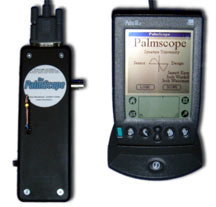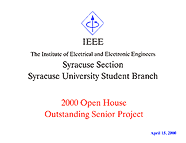Welcome to the PalmScope.
Syracuse University L.C. Smith Dept. of Engineering and Computer Science
Senior Project
by Josh Wardell, Jarrett Kern, and Josh Weissman (Computer Engineering).
 What is it?
What is it?
Essentially, the PalmScope is an Oscilloscope and Logic Analyzer for the PalmTM Connected Organizer.
This includes PalmOS TM-based software as well as a signal acquisition module and Microsoft Windows TM software. The Palm software takes the user input of various settings and controls the hardware module. The hardware module then triggers on the specified signal or pattern, captures the signal data, and returns it to the Palm. The Palm software then displays the captured data on the Palm's screen, allowing zooming and cropping, as well as saving to a Palm database. The Windows software, via a HotSync®, then obtains the saved data from the Palm, displaying it on a PC computer and allowing the user to further make use of the data, including sending it to a printer.
What are the advantages over standard components?
Cost, Size, and Ease of Use. Did we mention cost?
Intended for educational and hobbyist use, the PalmScope has several advantages over standard oscilloscopes and logic analyzers. Although it could not reach the resolution of these devices, the PalmScope is more than adequate for simple projects that are built by hobbyists and in college courses. Let's do a quick comparison:
| |
Oscilloscope |
Logic Analyzer |
the PalmScope |
| Cost |
$2500-$15,000 |
$5000-25,000 |
$25-$200 |
| Size |
20"x15"x8" |
20"x15"x8" |
3"x8"x1" |
| Interface |
20+ knobs & buttons |
15+ knobs & buttons |
GUI touch screen |
All numbers are very approximate...but you get the point! Not to mention the PalmScope is battery powered making it completely portable! In addition to any Palm organizer ($150-300), the hardware was built for about $25 in parts. The interface is very simple: one menu with a few selections, and a dialog of settings for sampling time and triggering.
These advantages can only improve in mass production. Including even lower costs, more development resources (read: time and money) could yield more signal channels, more data capacity, and a case that simply clips on the bottom of the Palm.

Sound too good to be true?
It isn't! We demonstrated a fully functional PalmScope for the Engineering and Computer Science Open House on April 15, 2000.
Click links below for more information and pictures.
.:| Product Pictures |:. .:| Open House Pictures |:.
Contact
As this was a proof-of-concept student project we are sorry we are unable to provide additional specific information including source code, and the PalmScope is not in production nor available for sale. However if you still have additional questions or are working on a similar student project you may contact any of us:
Josh Wardell
Josh Weissman
Jarrett Kern
|

